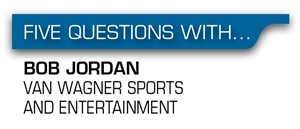With the proliferation of high-def flat screens in the homes of sports fans, making the experience at the venue equal or better is now a paramount concern for venue and team marketers. Bob Jordan, recently hired by Van Wagner Sports and Entertainment as senior vice president, has been doing that for years, at his own consultancy, as vice president of design and construction at MetLife Stadium, and as director of operations at American Airlines Center.
Jordan, who is also assisting MLB Advanced Media with its 30-ballpark Wi-Fi initiative, discussed the changing definition of the “state of the art stadium” with SportsBusiness Journal staff writer Terry Lefton.
■ How much have venue technology costs changed in your time?
JORDAN: When we started work on the American Airlines Center in Dallas in the late ’90s, we were struggling to distribute a high-def TV signal. We’d allocate between 3 and 6 percent of the construction budget to low-voltage networking stuff. Those same things now start at 10 to 15 percent of the construction budget and they’re going up. There are more space and distance restrictions than ever and they all impact cost and performance.
■ How do you forecast bandwidth requirements for a new stadium when things are changing so quickly?
JORDAN: The only certainty is that bandwidth is no longer an amenity, it’s a requirement. You try to figure on smartphone penetration, which is extensive, and try to figure out how many would be active users during a game. But it’s a Catch-22, because the more content you provide in a stadium, the more use you will get. Still, giving fans at an NFL game the ability to watch RedZone seems like something that’s way beyond nice to have. And there’s such a communal aspect of going to games, certainly we should want the social media to work as well as it can.
■ And the use patterns at venues are different, right?
JORDAN: Bandwidth demands at a stadium are unique. You go from 120 percent of capacity during game days to averaging maybe 5 percent the rest of the time. Balancing that out on a cost/benefit is very difficult. We’re dealing with a lot of unknowns in terms of new hardware, software and user requirements that can change so quickly. Adoption of 5K Wi-Fi was scattered and slow, then the iPhone 5 came on the market and since 5 million of them sold within a week or so, everyone wanted 5K right away.
■ So, the question of how much to budget simply for bandwidth requirements isn’t an easy one.
JORDAN: In a recent conversation with an NFL owner, he told me, “If everything else is equal, I don’t want a person staying home because he or she can’t stay connected at the game or call their baby sitter at home.” I have to provide enough connectivity for him so that decision never happens. At its best, technology changes the way things have always been done. We have the technology to do things very differently for fans. We could eliminate most of the lines at concessions with the right technology, but it has to be a focus.
■ There seems to be a built-in conflict between wireless sponsors at stadiums and the desire to offer universal connectivity within those venues.
JORDAN: It is probably not in your fans’ best interests to do an exclusive with any one carrier. … There are as many questions every day on how to monetize the second or third screen at venues as there are on giving fans enough bandwidth. Right now, we don’t have that many compelling apps at venue, because we don’t have the bandwidth yet. Another compelling question is whether once we have that infrastructure, will sports fans pay a premium beyond their ticket price for that. Teams have tried all different types of revenue models there. There does seem to be a lot of reticence by fans to pay for any type of wireless service once they have already bought what can be a fairly pricey ticket.





